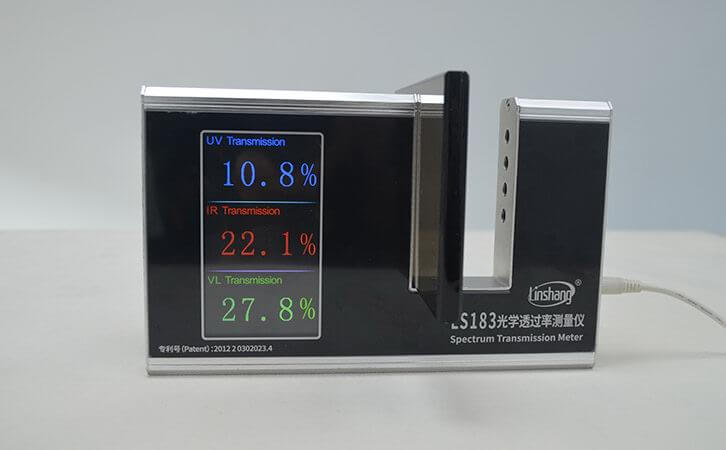Low-E Transmittance Detector-Spectrum Transmission Meter
Low-E glass is a kind of transparent glass, which can improve the overall performance of the glass through thin coating treatment. Low-e glass plays a significant role in buildings with large glass curtain walls. It can transmit visible light and reflect the ultraviolet and infrared radiation heat. It has high visible light transmittance and heat insulation effect. This glass has high requirements for visible light transmittance, UV and infrared transmittance of materials. Linshang Low-E glass spectrum transmission meter LS183 can accurately measure the visible light transmittance in 380nm-760nm, 365nm UV transmission, 940nm infrared transmission, which is an effective and fast transmittance measurement tool for Low-E glass.
1. Low-E glass functions
Low-E glass is also known as low-emissivity glass, was created to minimize the amount of infrared and ultraviolet light that comes through the glass. In summer, it can transmit visible light. At the same time, the Low-E glass can block the strong infrared radiation heat released from asphalt roads, buildings, which greatly reduce the air conditioning cost in the room. In winter, visible light can enter the room. At the same time, the infrared radiation heat in the room is reflected back into the room, so that heat will not be lost through the Low-E glass, so that the indoor temperature can be excellently maintained, and the heating cost in the winter room can be reduced.
2. How to measure the transmittance of Low-e glass?
Based on the characteristics of Low-E glass, it is generally required to measure the visible light transmittance, UV and IR transmittance when measuring the optical properties of Low-E glass. Linshang Technology LS183 UV transmittance meter is an instrument specially designed to measure the visible light transmittance, infrared transmittance and UV transmittance of glass.
The LS183 spectrum transmission meter can simultaneously measure three parameters. With a 47mm test slot, it is not only suitable for measuring single-layer coating Low-E glass, but also for the large thickness Low-E glass. Next, we will demonstrate how to measure the optical performance of Low-E glass.
After connecting the instrument to the power supply, turn it on.
When the Spectrum Transmission Meter screen shows three 100%, put the Low-E glass to be tested.
As shown in the figure below, it can be seen that the visible light transmittance of this Low-E glass is 27.8%. The infrared transmittance is 22.1%.
In addition, you can also see the UV transmittance is 10.8%.
Under the same production process, if a Low-E glass has a high visible light transmittance and a low infrared transmittance, we can basically judge that this glass is a relatively good Low-E glass.
Low-E glass has superior light transmission and thermal insulation properties compared to ordinary glass and traditional architectural coated glass. However, in today's advocacy of energy saving and emission reduction, we are unable to visually identify whether the various glasses on the market really have the excellent performance of Low-E glass. Therefore, if you want to choose really good Low-E glass, it is recommended to measure the visible light transmittance, IR transmission and UV transmission by the above Low-E glass spectrum transmission meter.
Want to know more details about other light transmission meters, please read "Light Transmission Meter Selection and FAQ".
- Why Measured Data from LS103A isn't Consistent From LS183 Spectrum Detective
- Linshang LS183 Light Transmission Meter
- Anti-blue Glass Lens Tester, Myopia People Should Pay Attention
- How to Maintain the Anti-blue Transmission Meter
- Compare Test Data of Linshang LS183 and LS108H Optical Transmission Meter
- LS183 Thermal Insulation Coating Tester

